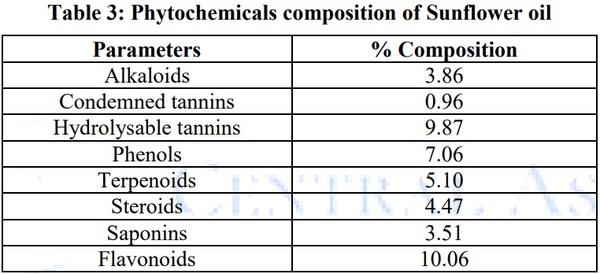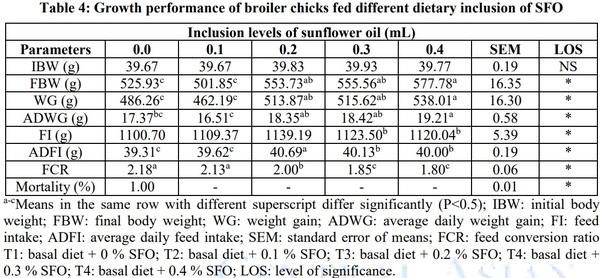Influence of Dietary Inclusion of Sunflower (Helianthus Annus) Oil on Growth Performance and Oxidative Status of Broiler Chicks





1. Olafadehan, O.A., Oluwafemi, R.A and Alagbe, J.O (2020). Carcass quality, nutrient retention and caeca microbial population of broiler chicks administered Rolfe (Daniellia oliveri) leaf extract as an antibiotic alternative. Journal of Drug Discovery. 14(33):146-154.
2. A.O.A.C.(2000). Association of Official Analytical Chemists. Official Methods of Analysis 19th
Edition Washington, D.C Pages 69-77.
3. Oluwafemi, R.A., Agubosi, O.C.P and Alagbe, J.O. (2021). Proximate, minerals, vitamins and amino acid composition of Prosopis africana (African mesquite) seed oil. Asian Journal of
Advances in Research 11(1): 21-27.
4. Oluwafemi, R.A., Uankhoba, I.P and Alagbe, J.O. (2021). Effects of turmeric oil as a dietary supplements on the growth performance and carcass characteristics of broiler chicken.
International Journal of Orange Technologies, 3(4): 1-9.
5. Olafadehan, O.A., Oluwafemi, R.A and Alagbe, J.O. (2020). Performance, haemato-biochemical parameters of broiler chicks administered Rolfe (Daniellia oliveri) leaf extract as an antibiotic alternative. Advances in Research and Reviews, 2020, 1:4.
6. Oluwafemi, R.A., Isiaka Olawale and Alagbe, J.O. (2020). Recent trends in the utilization of medicinal plants as growth promoters in poultry nutrition- A review. Research in: Agricultural and
Veterinary Sciences. 4(1): 5-11.
7. Mahipal, C., Ashak, K.P., Shalini, B., Narayan, D., Sunil, E.J and Kusumakar, S. (2015). Dietary supplementation of a novel phytogenic feed additive: effects on nutrient metabolism, antioxidant status and immune response of goats. Animal Production Science, 2:21-28. http://dx.doi.org/10.1071/AN14770.
8. Alagbe, J.O. (2019). Haematology, serum biochemistry, relative organ weight and bacteria count of broiler chicken given different levels of Luffa aegyptiaca leaf extracts. International Journal of
Advanced Biological and Biomedical Research. 7(4):382-392.
9. Omokore, E.O and Alagbe, J.O. (2019). Efficacy of dried Phyllantus amarus leaf meal as an herbal feed additive on the growth performance, haematology and serum biochemistry of growing rabbits.
International Journal of Academic Research and Development. 4(3): 97-104.
10. Alagbe, J.O., Shittu, M.D and Eunice Abidemi Ojo (2020). Prospect of leaf extracts on the performance and blood profile of monogastric – A review. International Journal of Integrated
Education. 3(7): 122-127.
11. Alagbe, J.O and Oluwafemi, R.A. (2019). Growth performance of weaner rabbits fed Noni (Morinda citrifolia) and Moringa olifera leaf mixture as partial replacement of soya bean meal.
International Journal of Advanced Biological and Biomedical Research. 7(2): 185-195
12. Aduku, A. O. (1994). Nutrient requirement of chicken. Feed ingredient analysis table and their uses. In: Revamping poultry production, feeding and management training manual. Edited by S.
O. Ogundipe, O. O. Oni and A. A. Sekoni, NSPRI/ ABU Shika- Zaria.
13. Adewale, A.O., Alagbe, J.O., Adeoye, Adekemi. O. (2021). Dietary Supplementation of Rauvolfia
Vomitoria Root Extract as A Phytogenic Feed Additive in Growing Rabbit Diets: Haematology and serum biochemical indices. International Journal of Orange Technologies, 3(3): 1-12.
14. Agubosi, O.C.P., Oluwafemi, R.A., and Alagbe, J.O. (2021). Preliminary study on GC-MS analysis of Prosopis africana seed (African mesquite) oil. Journal of Ethics and Diversity in
International Communication 1(4): 18-20.
15. Agubosi, O.C.P., Oluwafemi, R.A and Alagbe, J.O. (2021). The effect of processing on the proximate, mineral and vitamin composition of Neem leaves (Azadirachta indica) grown in
Gwagwalada, FCT, Abuja. Abuja Journal of Agriculture and Environment, 1(1): 293-299.
16. Shittu, M.D and Alagbe, J.O. (2020). Phyto-nutritional profiles of broom weed (Sida acuta) leaf extract. International Journal of Integrated Education. 3(11): 119-124.
17. Alagbe, J.O., Shittu, M.D and Tanimomo, Babatunde K. (2022). Influence of Anogeissusleio carpus stem bark on the fatty acid composition in meat of broiler chickens. European Journal of
Life Safety and Stability 14(22): 13-22.
18. Agubosi, O.C.P., Imudia, Favour Dumkenechukwu and Alagbe, J.O. (2022). Evaluation of the nutritional value of air dried and sun-dried sweet potato (Ipomoea batatas) peels. European
Journal of Life Safety and Stability 14(22): 43-51.
19. Chinelo, A.E and Ujunwa, C.N. (2017). Investigation of phytochemical and proximate components in different parts of Boerhavia diffusa and B. erecta L. Advances in Sciences, 2(5):60-63
20. Chiasson H,. Belanger A, Bostanian N. 2001. Acaridial properties of Atermisia absinthium and
Tanacetum vulgare (Asteraceae) essential oils obtained by three methods of extraction. Applied
Environment Microbial. 47:229-233
21. WHO (World Health Organization) (2014). Antimicrobial Resistance: Global Report on
Surveillance 2014. Accessed June 2019.
22. Windisch W, Schedle K, Plitzner C, Kroismayr A. (2008). Use of phytogenic products as feed additives for swine and poultry. Journal of Animal Science 86:140-8.
23. Franz C, Baser K, Windisch W. (2010). Essential oils and aromatic plants in animal feeding a
European perspective. A review. Flavour Fragr Journal 25:327-40.
24. Bento M, Ouwehand A, Tiihonen K, Lahtinen S, Nurminen P, Saarinen M. (2013). Essential oils and their use in animal feeds for monogastric animals-Effects on feed quality, gut microbiota, growth performance and food safety: a review. Journal of Veterinary Medicine 58:449-58.
25. Amad A, Maanner K, Wendler K, Neumann K, Zentek J.(2011). Effects of a phytogenic feed additive on growth performance and ileal nutrient digestibility in broiler chickens. Poultry Science
90:2811-6.
26. Jamuna S, Paulsamy S, Karthika K. (2014). In vitro antifungal activity of leaf and root extracts of the medicinal plant, Hypochaeris radicata L. International Journal Pharmaceutical Science 5(3):
758-761.
27. Labaran, I., Lukman, O.A., Adam, J.D and Usman, M. (2016). Analysis of some phytochemicals and minerals found in aqueous stem bark of Albizia lebbeck. Dutse Journal of Pure and Applied
Science, 2(1): 231-237.
28. Sittanikove, Y.X, Yeo, C.R, Chung HL, Yuk, H.G. (2001). Plant essential oils as active antimicrobial agents. Critical Review Food Science and Nutrition 54:625-44.
29. Atamgba, A. A., Margret, A. A., Kayode, D. and Amonor, J. W. (2015). The biomedical significance of the phytochemical, proximate and mineral composition of the leaf, stem bark and roots of Jatropha curcas. Asian Pacific Journal of Tropical Biomedicine, 5(8):650-657
30. Enzo, A. P. (2007). Traditional plants and herbal remedies used in the treatment of diarrheal disease: Mode of action, quality, efficacy and safety considerations. In: Ahmad, I., Aqil, F. and
Owais, M. editors Modern Phytomedicine Turning Medicinal Plants in to Drugs, 248-260.
31. Hollman, P.C. (2001). Evidence for health benefits of plant phenols: Local or systemic effects.
Journal of Food science and Agriculture, 81: 842-852.
32. Halle, I., Thomann, R., Bauermann, U., Henning, M. and Kohler, P. (2004). Effects of a graded supplementation of herbs and essential oils in broiler feed on growth and carcass traits.
Landbauforshung Volkenrod, 54:219-229.
33. Gadde, F., Madrid, J., Garcia, V., Orengo, J. and Megias, M. (2017). Influence of two plants extracts on broilers performance, digestibility, and digestive organ size. Poultry science, 83:169-
174.
Boham, B. A. and Kocipai, A. C. (1974). Flavonoids and condensed tannins from leaves of
Hawaiian vaccinium vaticulatum and V. calycinium. Pacific Sci. 48: 458-463.
34. Harborne, J. D. (1973). Phytochemical methods: A guide to modern techniques of plant analysis.
Chapman and Hall, London. 279.
35. Odebiyi, A. and Sofowora, A. E. (1978). Phytochemical Screening of Nigerian Medicinal Plant.
Part III, Lloydia, 41, 234- 246.


United States






